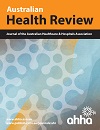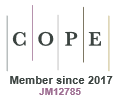What is known about the topic? Digital health innovations provide an option to complement face-to-face healthcare services. What does this paper add? This paper identifies 10 key processes that illustrate value-based healthcare principles in delivering digital health innovations. What are the implications for practitioners? Those developing digital health innovations could use these 10 key processes to investigate how their service can enhance existing healthcare services, emphasising the importance of integrating with face-to-face care rather than operating in isolation. Organisations developing or updating digital health strategic documents may use insights from this analysis to advocate for priority populations.

Australian Health Review
Volume 49 Number 3 2025
What is known about the topic? Artificial intelligence (AI) medical scribes aim to reduce documentation burdens by transcribing patient–clinician interactions in real-time. Although mainly studied with doctors, they offer potential benefits such as improved efficiency and patient engagement. However, concerns include accuracy, workflow integration, and diverse documentation needs. What does this paper add? This paper highlights research gaps and the need for discipline-specific evaluations of AI scribes in allied health. What are the implications for practitioners? Practitioners should consider AI scribes' potential benefits and limitations and undertake more research into their application in allied health settings.
AH25041Evaluation of the Aboriginal and Torres Strait Islander Outpatient Clinic: a mixed-methods study
What is known about the topic? Aboriginal and Torres Strait Islander peoples face barriers to accessing health care and, in response, a culturally safe and consumer-focused outpatient service was developed. What does this paper add? An understanding of what is working well, what could be improved and recommendations of the service model. What are the implications for practitioners? The findings contribute to a better understanding of enablers to accessing health care for Aboriginal and Torres Strait Islander peoples.
What is known about the topic? Voluntary assisted dying is a legal end-of-life option in all Australian states, but not all health services support or offer it. In Queensland, the law prescribes actions that non-participating health services must take so that access to voluntary assisted dying is not hindered. What does this paper add? This study explores how privately funded health services in Queensland prepared for the implementation of voluntary assisted dying, highlighting the anticipated challenges. What are the implications for practitioners? Organisational policies related to voluntary assisted dying can support practitioners to ensure their practice meets their legal obligations.
What is known about the topic? Healthcare gaps mean people with type 2 diabetes struggle to attain management goals. Smartphone-based digital health interventions can improve diabetes outcomes, but rely on smartphone ownership and confidence with use. Populations experiencing increased burdens of diabetes overlap with those experiencing barriers to smartphone uptake, potentially contributing to health inequity. What does this paper add? In a socioeconomically marginalised, multiculturally diverse community healthcare setting, we describe the prevalence of smartphone ownership, app use and internet access and factors around uptake and utilisation. What are the implications for practitioners? Smartphone ownership and utilisation are unlikely to be barriers to future uptake of smartphone-based digital health interventions. Focus on tailored supports is needed for older adults and females.
AH24324A guide to using measures of socio-economic status, remoteness and population denominators from the Australian Bureau of Statistics for epidemiological studies
Online short summary
What is known about this topic? The Australian Bureau of Statistics (ABS) produces resources to characterise areas in terms of socio-economic status and service accessibility. These resources are useful, though complex. What does this paper add? An overview of these ABS-produced resources and considerations in their use. The paper includes files and computer code to attach this information to administrative research data. What are the implications for practitioners? This paper will aid research projects and will build research capacity.
AH25032Assessing the value of online palliative care information
What is known about the topic? Evidence pertaining to the value of online palliative care information is limited and metrics such as usage data may not be sufficient to determine efficacy. What does this paper add? This paper assesses the value of online palliative care information and provides an innovative description of the cultural, demographic, institutional, and technological eco-system within which online palliative care knowledge is being translated. What are the implications for practitioners? Maximising the impact of online palliative care information requires improvements in access to evidence, visibility, usability, and the development of resources tailored to diverse users.
AH25032 Abstract | AH25032 Full Text | AH25032PDF (324 KB) | AH25032Supplementary Material (273 KB) Open Access Article
What is known about this topic? There is emerging evidence that research capacity and culture of allied health professionals may be different to medically trained health professionals. What does this paper add? This paper provides understanding of how research engagement is perceived by a large group of psychologists working in public health in Australia and describes motivators and barriers that influence their research engagement. What are the implications for practitioners? This paper suggests that a targeted future capacity building strategy is required to improve research engagement of Australian psychologists working in public health.
What is known about this topic? Effective midwifery workforce planning requires an understanding of the size of the workforce and the prediction of future possibilities, especially attrition. What does this paper add? The Midwifery Futures workforce model demonstrates ongoing growth of the midwifery workforce, assuming no changes to recruitment and attrition. An increase in voluntary attrition would have devastating consequences. What are the implications for practitioners? Increased student recruitment and efforts to retain midwives by focusing on improved workplaces, increased flexibility, and increased access to midwifery continuity of carer roles may stabilise the Australian midwifery workforce.
AH24337 Abstract | AH24337 Full Text | AH24337PDF (1.2 MB) | AH24337Supplementary Material (582 KB) Open Access Article
AH24229Private car travel is the dominant form of transport to work for healthcare workers across Greater Western Sydney: a short report on a large travel survey
What is known about the topic? Understanding commuting patterns of healthcare workers is important but relatively little is known. What does this paper add? This study explores different commuting modes and the barriers to active travel and public transport use among healthcare workers, finding car travel to be the most prevalent. What are the implications for practitioners? The findings highlight the need for targeted interventions to promote sustainable commuting options, which can improve health outcomes and reduce environmental impact.
What is known about the topic? There are still significant pressures on the healthcare system from a workforce perspective. Job demands are still exceeding job resources. Relatively little is known about how human resource management (HRM) and management support can contribute effectively to improve the psychological wellbeing of medical radiation practitioners (MRPs). What does this paper add? This paper details the workplace issues faced by MRPs and contributes to literature on wellbeing HRM in the allied health sector. What are the implications for practitioners? Identification of a collaborative multi-level management approach is required to actively support MRPs to manage and address mental health and wellbeing issues.
What is known about the topic? Despite the critical importance of communication and collaboration within multidisciplinary healthcare teams, there is limited literature addressing interventions that are both effective and feasible in a busy hospital setting. What does this paper add? This paper evaluates the Hospital Harmony program, a brief, group-based intervention that was well-received and significantly enhanced psychological safety and communication within a general medicine multidisciplinary team. What are the implications for practitioners? The Hospital Harmony program has the potential to be adapted for use in other multidisciplinary healthcare teams, improving team functioning and ultimately patient care.
What is known about the topic? The potential of digital health to transform Australia’s healthcare system by improving sustainability, access and equity, and meeting the demands for a future-ready workforce, has not yet been realised. What does this paper add? This paper outlines an action plan developed by the Australian Council of Senior Academic Leaders in Digital Health to advance digital health research and education. What are the implications for practitioners? Advancing digital health transformation in Australia requires effective engagement with and across our universities, which is essential to drive collective action and progress in health care.
AH25039 Abstract | AH25039 Full Text | AH25039PDF (323 KB) Open Access Article
What is known about the topic? Artificial intelligence (AI) has the potential to assist in generating medical documents, but evidence regarding its effectiveness in creating emergency department (ED) discharge summaries is limited. What does this paper add? This study shows that AI-generated discharge summaries were rated comparably to ED medical notes in expected contents, readability, and internal consistency. What are the implications for practitioners? AI could be a valuable tool for enhancing efficiency and accuracy in creating ED discharge summaries, supporting clinicians in delivering high-quality patient care. It is possible to use ChatGPT4 to produce succinct discharge summaries. AI-generated discharge summaries are potentially comparable to the comprehensive medical notes written by doctors.
What is known about the topic? Australians eligible for public oral healthcare can wait a long time for an appointment. What does this paper add? This analysis provides an update and 10-year review (2015–2024) of numbers waiting for care, and numbers and percentages waiting beyond a desirable time for their clinical priority group, in Queensland. What are the implications for practitioners? Clear and feasible strategies need to be implemented to substantially reduce waiting list numbers in Queensland and more broadly across Australia; including appropriate federal and state government funding of public oral healthcare.
AH24300The role of Medicare policy in fertility treatment decisions: perceptions of Australians considering, undertaking or who have undertaken medically assisted reproduction treatment
What is known about the topic? Fertility treatment can be expensive and not all people who require fertility treatment can access financial assistance from Medicare. What does this paper add? For those eligible for assistance, Medicare enhances accessibility and the amount of treatment undertaken due to increased affordability. People also alter their treatment plans based on Medicare policy. What are the implications for practitioners? The findings support calls for changes to Medicare eligibility to enable equitable access to fertility treatment and a pathway to parenthood for all Australians.
AH24287_COCorrigendum to: What factors affect the recruitment and retention of allied health professionals working in hospitals? A systematic literature review
What is known about the topic? Implementation of eHealth has been unfolding in hospitals for over the past decade, and impact evaluations are needed to provide insights into justifying expenditure. What does this paper add? This paper extends two consecutive narrative reviews of systematic reviews and provides a meta-review of the impacts of eHealth technologies published between 2010 and 2021. We observed largely mixed findings for CPOE, EMR, and ePrescribing, and largely positive findings for CDSS. What are the implications for practitioners? eHealth has the potential to improve a breadth of outcomes, but there is no guarantee and effortful work is needed.
What is known about the topic? In the face of escalating demands, our existing care systems are not delivering efficient, safe, high-quality and complex care that meets the diverse needs of individuals and communities. What does this paper add? Our series of co-design activities generated a True North Statement that can serve as a shared action-focused vision to transform health and social care in Australia over the next decade. What are the implications for practitioners? Our True North Statement is a starting point to guide individual, organisation and system redesign. The statements are sequential and require action at individual consumer, workforce and system levels.
What is known about the topic? Accurate documentation of severe medication allergies is essential to prevent morbidity and mortality from inadvertent re-exposure. My Health Record is a national patient-controlled electronic health record. The accuracy of allergy information in My Health Record has not been previously evaluated. What does this paper add? Inaccurate documentation of confirmed serious medication-related allergies was prevalent, contributed by several system level barriers. What are the implications for practitioners? Accurate allergy documentation in My Health Record and medication safety can be improved through streamlining pathways for hospital clinicians and specialists to enter important information.
What is known? Advance care directives are important so that individuals can plan for the medical treatment they want to receive when they are unable to medically or cognitively make those decisions. Unfortunately for many reasons uptake is low. What does this paper add? Increase in uptake can occur if a health professional individualises support at the right time in the right place and targets the right people. What are the implications for practitioners? Dedicated staff are required to provide time, education and empathy to support people to empower themselves to make decisions about their future medical care.
AH25060 Abstract | AH25060 Full Text | AH25060PDF (432 KB) Open Access Article
What is known about the topic? The ageing population and increasing incidence of chronic illness pose significant end-of-life healthcare challenges. advance care planning (ACP) completion rates are low across Australia, varying by location and healthcare setting. What does the paper add? This study identifies predictors for ACP and advance care directive completion, including having a will, advancing age, being female, having private health insurance, not working, and having one or more medical conditions. What are the implications for practitioners? These findings could inform interventions to improve ACP uptake, guide healthcare professionals to identify groups that engage less in ACP and inform future research.
AH24327 Abstract | AH24327 Full Text | AH24327PDF (356 KB) | AH24327Supplementary Material (286 KB) Open Access Article




